-
Cangzhou Yulong Steel Co., Ltd.
-
Phone:
+86 13303177267 -
Email:
admin@ylsteelfittings.com
- English
- Arabic
- Italian
- Spanish
- Portuguese
- German
- kazakh
- Persian
- Greek
- French
- Russian
- Polish
- Thai
- Indonesian
- Vietnamese
- Zulu
- Korean
- Uzbek
- Hindi
- Serbian
- Malay
- Ukrainian
- Gujarati
- Haitian Creole
- hausa
- hawaiian
- Hebrew
- Miao
- Hungarian
- Icelandic
- igbo
- irish
- Japanese
- Javanese
- Kannada
- Khmer
- Rwandese
- Afrikaans
- Albanian
- Amharic
- Armenian
- Azerbaijani
- Basque
- Belarusian
- Bengali
- Bosnian
- Bulgarian
- Catalan
- Cebuano
- China
- China (Taiwan)
- Corsican
- Croatian
- Czech
- Danish
- Esperanto
- Estonian
- Finnish
- Frisian
- Galician
- Georgian
- Kurdish
- Kyrgyz
- Lao
- Latin
- Latvian
- Lithuanian
- Luxembourgish
- Macedonian
- Malgashi
- Malayalam
- Maltese
- Maori
- Marathi
- Mongolian
- Myanmar
- Nepali
- Norwegian
- Norwegian
- Occitan
- Pashto
- Dutch
- Punjabi
- Romanian
- Samoan
- Scottish Gaelic
- Sesotho
- Shona
- Sindhi
- Sinhala
- Slovak
- Slovenian
- Somali
- Sundanese
- Swahili
- Swedish
- Tagalog
- Tajik
- Tamil
- Tatar
- Telugu
- Turkish
- Turkmen
- Urdu
- Uighur
- Welsh
- Bantu
- Yiddish
- Yoruba

Sep . 22, 2024 19:18 Back to list
different kinds of couplings
Different Kinds of Couplings An Overview
Couplings are essential mechanical devices used in various applications to connect two shafts together for the purpose of transmitting power. They play a critical role in ensuring the efficiency and reliability of machinery across a myriad of industries, from automotive to aerospace and industrial machinery. Understanding the different kinds of couplings available is crucial for engineers and designers when selecting the appropriate type for their specific applications.
1. Rigid Couplings
Rigid couplings provide a fixed connection between two shafts. They do not accommodate any misalignment, which makes them suitable for applications where precise alignment is maintained. These couplings are often used in applications that require the transfer of high torque without any losses, such as in gearboxes and pumps. However, their inability to handle misalignments can lead to increased wear and tear, making them less suited for dynamic or high-vibration environments.
2. Flexible Couplings
Flexible couplings, as the name suggests, allow for some degree of misalignment between connected shafts. This flexibility can be crucial in applications where vibrations or movement are inherent. There are several types of flexible couplings, including
- Rubber Couplings These utilize rubber as a flexible element that can absorb shock and vibrations. They are commonly used in applications where noise reduction is essential.
- Oldham Couplings Designed to accommodate parallel misalignment, Oldham couplings consist of two hubs and a central disc
. They are especially useful in applications involving heavy loads and varying alignments.different kinds of couplings

- Universal Joints Commonly seen in automotive driveshafts, universal joints allow for angular misalignment between shafts. They can transmit power at varying angles, making them suitable for dynamic and complex motions.
3. Fluid Couplings
Fluid couplings are non-mechanical couplings that use hydraulic fluid to transfer torque from one shaft to another. This type is particularly advantageous in applications that require smooth start-ups and soft engagement, such as in heavy machinery and marine applications. By reducing shock loads and preventing sudden jerks, fluid couplings can extend the life of connected components significantly.
4. Magnetic Couplings
Magnetic couplings utilize magnetic forces to connect two shafts without physical contact. This unique feature allows for the transfer of torque while isolating the components from external contaminants, making them perfect for cleanroom applications, magnetic pumps, and other environments where traditional couplings might fail.
5. Coupling Selection Considerations
When choosing a coupling, several factors should be taken into account, including the type of load, speed of operation, environmental conditions, and the permissible level of misalignment. Each type of coupling has its advantages and limitations, making it essential to evaluate the specific needs of the application.
In conclusion, couplings are vital components in mechanical systems, and selecting the right type can significantly impact performance and longevity. By understanding the various kinds of couplings and their characteristics, engineers can make informed decisions to optimize their designs and operations. Whether it’s rigid, flexible, fluid, or magnetic, the appropriate coupling can enhance the efficiency and reliability of machinery across diverse applications.
Latest news
-
ANSI 150P SS304 SO FLANGE
NewsFeb.14,2025
-
ASTM A333GR6 STEEL PIPE
NewsJan.20,2025
-
ANSI B16.5 WELDING NECK FLANGE
NewsJan.15,2026
-
ANSI B16.5 SLIP-ON FLANGE
NewsApr.19,2024
-
SABS 1123 FLANGE
NewsJan.15,2025
-
DIN86044 PLATE FLANGE
NewsApr.19,2024
-
DIN2527 BLIND FLANGE
NewsApr.12,2024
-
JIS B2311 Butt-Welding Fittings LR/SR 45°/90° /180°Seamless/Weld
NewsApr.23,2024











